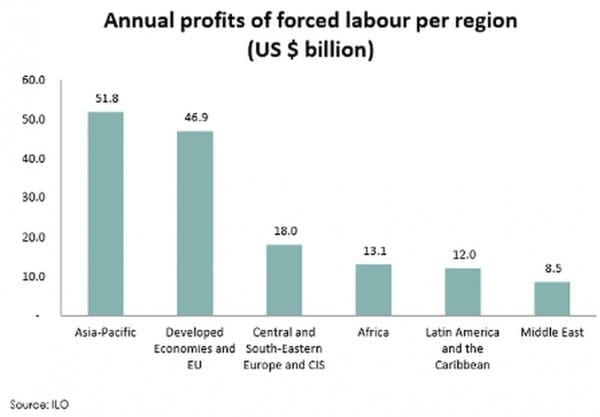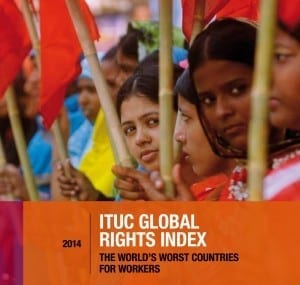Aug 7, 2014
 Full employment should be a policy goal for all countries, regardless of level of development, according to the latest United Nations Development Program (UNDP) report. The report emphasizes the importance of meaningful, decent work for developing a worker’s dignity and creating community cohesion.
Full employment should be a policy goal for all countries, regardless of level of development, according to the latest United Nations Development Program (UNDP) report. The report emphasizes the importance of meaningful, decent work for developing a worker’s dignity and creating community cohesion.
“Sustaining Human Progress: Reducing Vulnerabilities and Building Resilience” also emphasizes that young people are especially at risk for unstable work because of lack of job experience and financial instability. Even employed young people are vulnerable, experiencing lay-offs and pay cuts during economic downturns. Despite the challenges, the report says, the growing youth population can potentially bring more educated and more productive workers into the economy.
According to the report, South Asia and sub-Saharan Africa have the highest rates of vulnerable employment—some 77 percent of the total workforce in 2011. The same regions have the highest rate of working poor. As far back as 1993, UNDP identified jobless growth, where output increases, but employment lags behind. In addition, even as productivity increased, workers’ wages remained fairly stagnant.
The report highlights South Africa among three countries experiencing improvements in equality of marginalized groups. Because apartheid left the workforce divided by race, leaving only unskilled jobs for minorities, the country introduced an Employment Equity Act in 1998. This act encouraged women and members of minority groups to participate in the workforce, reducing unemployment and poverty. The act, in conjunction with other more specific efforts, has helped change the racial distribution of South Africa’s workforce and included historically disadvantaged groups.
In a special contribution to the report, Juan Somavia, former director general of the International Labor Organization, says modern economic thinkers see work as “only” a production cost.
“Nowhere in sight is the societal significance of work as a foundation of personal dignity, as a source of stability and development of families or as a contribution to communities at peace,” he writes. Somavia then outlines his policy recommendations: living wages, respect for worker rights, gender equality, workers organization and collective bargaining and pensions, among others.
Stable, decent employment not only provides workers and their families with financial security but can also boost a sense of dignity and status within the community. Higher rates of female employment can also widely benefit communities, in part by changing the perception of the “value” of girls, increasing female education and reducing poverty.
Read the full report.
May 21, 2014

Some 21 million women, men and children are in forced labor, trafficked, held in debt bondage or work in slave-like conditions worldwide, and their toil generates an estimated $150 billion in illegal profits in the private global economy, according to a new report by the International Labor Organization (ILO). The $150 billion in illegal profits is three times more than the previous ILO estimate.
he majority of those in forced labor are women and girls, who make up 55 percent of the total, compared with 9.5 million (45 percent) men and boys. Many of these women are domestic workers. Of the 52.6 million domestic workers worldwide, the report estimates 3.4 million—6.5 percent—are in forced labor. Further, many domestic workers are migrants, often exploited by labor brokers and employers. The report notes that an estimated $8 billion is literally stolen annually from domestic workers in forced labor who, on average, are effectively deprived of 60 percent of their wages.
Overall, $51 billion of the estimated $150 billion in illegal profits results from forced economic exploitation, including domestic work and agriculture, areas where women make up much or most of the workforce. Commercial sexual exploitation accounts for $99 billion.
“Profits and Poverty: The Economics of Forced Labor” finds solid evidence for a correlation between forced labor and poverty. In countries where the ILO measured “income shocks” and food insecurity, such as Niger and Bolivia, a larger percentage of forced laborers than people who worked freely came from households where income had declined. In Nepal, only 9 percent of workers in forced labor had lived in food-secure households, compared with 56 percent of freely employed individuals.
The report finds the profit from forced labor is generated from three broad areas:
• $34 billion in construction, manufacturing, mining and utilities.
• $9 billion in agriculture, including forestry and fishing.
• $8 billion saved by private households by not paying or underpaying domestic workers held in forced labor.
An individual is considered to be working in forced labor, according to the ILO’s survey guidelines, if his or her recruitment was not free and involved some form of penalty at the time of recruitment, and if that individual works and lives under duress, and faces any penalty or cannot leave the employer because of the menace of a penalty.
• Read a summary of the report.
• Read the full report.
• In this video, ILO Director General Guy Ryder urges immediate action to end forced labor.
May 21, 2014
 Uruguay, South Africa and Germany are some of the countries with the best worker rights records in 2013, while Cambodia, Guatemala and Nigeria are among the worst, according the 2014 Global Rights Indexreleased this week by the International Trade Union Confederation (ITUC).
Uruguay, South Africa and Germany are some of the countries with the best worker rights records in 2013, while Cambodia, Guatemala and Nigeria are among the worst, according the 2014 Global Rights Indexreleased this week by the International Trade Union Confederation (ITUC).
The annual index, which documents violations in 139 countries recorded between April 2013 and March 2014, found that in the past 12 months:
- Murder and disappearance of workers were commonly used practices to intimidate workers in at least nine countries.
- Governments of at least 35 countries have arrested or imprisoned workers as a tactic to resist demands for democratic rights, decent wages, safer working conditions and secure jobs.
- Workers in at least 53 countries have either been dismissed or suspended from their jobs for attempting to negotiate better working conditions. “In the vast majority of these cases,” the report notes, “national legislation offered either no protection or did not provide dissuasive sanctions” to hold abusive employers accountable. Rather, “employers and governments are complicit in silencing workers’ voices against exploitation.”
- Laws and practices in at least 87 countries exclude certain categories of workers from the right to strike. At least 35 countries impose fines or even imprisonment for legitimate and peaceful strikes.
The most frequent violation of worker rights occurred when workers went on strike, followed by violations of the rights of workers who sought to join unions.
The survey notes that because countries such as Qatar and Saudi Arabia exclude migrant workers from labor rights, more than 90 percent of the workforce effectively has no recourse for addressing forced labor practices which exist under archaic sponsorship laws.
“The World Bank’s recent ‘Doing Business’ report naively subscribed to the view that reducing labor standards is something governments should aspire to,” said Sharan Burrow, ITUC general secretary. “This new Rights Index puts governments and employers on notice that unions around the world will stand together in solidarity to ensure basic rights at work.”
The index assigns each country a score ranging from one to 5+, with 5+ indicating no guarantee of worker rights due to a complete breakdown in a country’s rule of law (for example, the Central African Republic and Ukraine), five indicating no guarantee of worker rights (for example, Bangladesh, Colombia, Malaysia) and “one” signaling that collective labor rights are generally guaranteed.
The report also offers a detailed look at six countries, one from each of the rankings: the Central African Republic, Cambodia, Kuwait, Ghana, Switzerland and Uruguay.
The ITUC Global Rights Index ranks the 139 countries against 97 internationally recognized indicators to assess where workers’ rights are best protected in law and practice.
Feb 28, 2014
Government restrictions and repression of citizens’ universal right to freedoms of assembly and association topped the list of violations in the State Department’s 2014 annual “Country Reports on Human Rights Practices.”
The report, released yesterday, also singled out the April collapse of the multistory Rana Plaza building in Bangladesh, which killed more than 1,100 garment workers, as among the worst incidences of human rights violations in 2013.
The congressionally mandated report is not an intellectual exercise, said Secretary of State John Kerry in discussing the findings.
It is “about accountability. It’s about ending impunity. The struggle for rights and dignity couldn’t be more relevant to what we are seeing transpire across the globe.”
Get the overview and the full report.
Read Kerry’s statement.
Sep 10, 2013
Trade unionists from dozens of countries are taking part in the quadrennial AFL-CIO Convention in Los Angeles this week—and the Los Angeles Times has video highlights of two international union leaders.
Zahoor Awan, general secretary of the Pakistan Workers Federation, said he is representing the Pakistani union movement in solidarity with the U.S. labor movement. “We share the same … defense of workers and trade union rights.”
Also in the clip is Myrtle Witbooi, general secretary of the South African domestic workers union SADSAWU. Witbooi is chairwoman of the International Domestic Workers NetWork (IDWN), which received the George Meany-Lane Kirkland Human Rights Award Sunday during the covention’s opening session.
“We want to say that domestic workers want respect, they want to be valued for what they are doing,” Witbooi told the Times. “Domestic workers want the same rights as other workers. We are workers like all other workers, so we demand the same respect as all other workers in the world.”
Check out the video.
Jun 22, 2013
Some 197 million people were jobless worldwide in 2012, and an additional 39 million workers have dropped out of the labor market, unable to find employment, according to a new report by the International Labor Organization (ILO).
The ILO predicts the situation will only get bleaker this year, with 5.1 million more workers likely to be unemployed. Young people are the hardest hit: 74 million young workers worldwide are unemployed, a staggering 40 percentof those unemployed globally.
“Global Employment Trends 2013” notes that although the global economy is expected to recover, growth will not be strong enough to bring down unemployment quickly, and predicts that unemployment worldwide will remain at 6 percent up to 2017, not far from its worst level in 2009. The number of unemployed workers is expected to rise further to some 210.6 million over the next five years.
Read the full report.
 Full employment should be a policy goal for all countries, regardless of level of development, according to the latest United Nations Development Program (UNDP) report. The report emphasizes the importance of meaningful, decent work for developing a worker’s dignity and creating community cohesion.
Full employment should be a policy goal for all countries, regardless of level of development, according to the latest United Nations Development Program (UNDP) report. The report emphasizes the importance of meaningful, decent work for developing a worker’s dignity and creating community cohesion.

